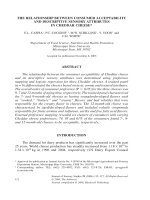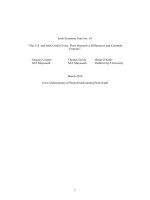Differences and similarities between prescriptive and descriptive strategiesx
Bạn đang xem bản rút gọn của tài liệu. Xem và tải ngay bản đầy đủ của tài liệu tại đây (42.02 KB, 3 trang )
Differences and similarities between prescriptive and descriptive strategies
Similarities
There is a strong similarity to descriptive and prescriptive strategies. As the
definition reads; descriptive: “what is usually done” or prescriptive: “what can be
done most realistically” could end up being the same outcome on many occasions.
The definitions even make sense when put together. What is usually done is most
likely what can be done most realistically. However, when studied in more depth,
these strategies have their differences.
Differences
The descriptive strategy is done based on past evidence. It is something that has
been most likely done in the past. Unlike the descriptive strategy, the prescriptive
strategy takes other factors into consideration while analyzing multiple criteria and
conflicting objections. After this, then chooses what strategy would or could be
done realistically based on the objectives previously listed. According to the
prescriptive strategy, the second best decision might be more appropriate. The
prescriptive approach includes an analysis of possible decisions around a chosen
solution known as sensitivity analysis.
For a better explanation, a descriptive approach may
be making a decision on a topic only based on past experience. If it was positive,
then we would make the same decision. If it was negative, then we would make a
different decision. Prescriptive strategy analyzes all options before deciding based
on all factors, what the best option may be.
Which approach are you comfortable with?
I believe most people are comfortable with the descriptive strategy. This is
because it is easier for them at any level to make a decision based on what is
usually done. However, this doesn’t seem to be a strategic approach. If
something is failing, most likely it will need a prescriptive approach to analyze
what went wrong and try to change it. It would not work to keep making the same
decision if the company was failing or losing money.
I have a history of coaching softball. When I teach hitting, one of the simple
objectives I use is if you strike out 3 times, you need to analyze what you are
doing, based on objectives such as pitching speed, weather elements, batting
stance, ect. These are all factors that if you keep doing the same thing, will result
in the same outcome. If someone keeps striking out, they would need a
prescriptive strategy to make a change.
Based
on T. Shimuzu’s “Art of War,” the principles of general nature come into play.
• Moral Law: degree to which the people trust their government
• The Sky: climate conditions
• The Earth: conditions of the land
• The Chief: virtues of wisdom, sincerity, benevolence, courage, and
righteousness
• The Method and discipline: the correct deployment of the army
These principles of nature in regards to the book support the prescriptive strategy.
What has been done before may not be able to be done because of these constantly
changing principles. In my opinion, I would say that war in general is a
prescriptive strategy. Knowing your enemy will lead to advancement in strategic
thinking. The strategy will always be different as the enemy changes.
I read an interesting article titled; “What characterizes the culture of a market –
oriented organization applying a customer-intimacy philosophy?” by A.
Osarenkhoe. This article talked about our business environment undergoing the
many changes during these economic times including consumer buyers changing,
lifestyle changes, and purchasing power increases. These changes have forced
businesses to adopt new approaches in order to address company’s long term need
for
survival. The article showed a graph that highlighted the plan for new customer-
intimacy business philosophy. The framework is shown as a descriptive strategy,
highlighting the areas or categories such as context, process and outcome. The
author investigated a Swedish company with the most satisfied customers to find
characteristics of the culture of a market oriented organization applying a customer
intimacy philosophy.
In closing, after my research on both prescriptive and descriptive strategies, I
believe that in our constantly changing world that we live in, it is probably more
important to take a prescriptive approach. Most situations are not always the same
so the descriptive strategy will not work.
References
Chu, C.-n. (2007). The Art of War for Women. New York, USA: The Doubleday
Broadway Publishing Group.
Osarenkhoe, A. (2008). What Characterizes the culture of a market-oriented
orginaization applying a customer-intimacy philosophy? Journal of Database
Marketing and Customer Service Management , 15 (3), 169-190.
T. Shimizu, M. M. (2006). Concepts and History of Strategy in Oganizations. In
Strategic Alignment Process and Decision Support Systems: Theory and Case
Studies. IGI Publishing.









